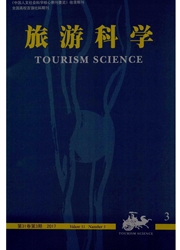

 中文摘要:
中文摘要:
2000年以来,我国人均收入超过1000美元,国内旅游进入快速增长期,呈现抗周期性的新特征。本文在形态指标分析的基础上,界定了旅游业抗周期的概念及两种表现形式。相关统计数据实证检验发现,2003年SARS危机后,2004年国内旅游强力反弹,2009年国民经济进入低谷期后国内旅游率先恢复,形成一种受短期波动影响较小的惯性增长。同时,本文依据1994年~2012年时间序列数据建立了双对数模型,分析全国及城市居民国内旅游收入弹性和价格弹性,结果显示,收入需求弹性大于价格需求弹性,收入增长对居民国内旅游的推动作用大于价格的限制,形成了“刚性”的旅游需求,这是新时期国内旅游迅猛增长及抗周期性形成的根本原因。
 英文摘要:
英文摘要:
China' s domestic tourism presents a new anti-cyclical characteristic since 2000, in which China' s per capita income reached $ 1000. The domestic tourism demand and expense have undergone a great increase, and tourism development has developed at a rapid pace. Based on morphological indicators, this paper defined the anti-cyclicality of domestic tourism, explained its short-term performance, and conducted an empirical test. The results show that: The short-term economic fluctuations impact on domestic tourism is relatively small, it rebounded first after the SARS crisis in 2003 and restored fast in the 2009 economic downturn period; it created a sort of inertia growth. In accordance with the time series of 1994 -2011, it established a double logarithmic model and calculated income elasticity of demand and price elasticity of demand. The findings suggest that the pulling effect of income on travel demand, which is the most fundamental reason for the new period of China' s domestic tourism, is far greater than price restrictions that forms a rigid demand for tourism.
 同期刊论文项目
同期刊论文项目
 同项目期刊论文
同项目期刊论文
 期刊信息
期刊信息
